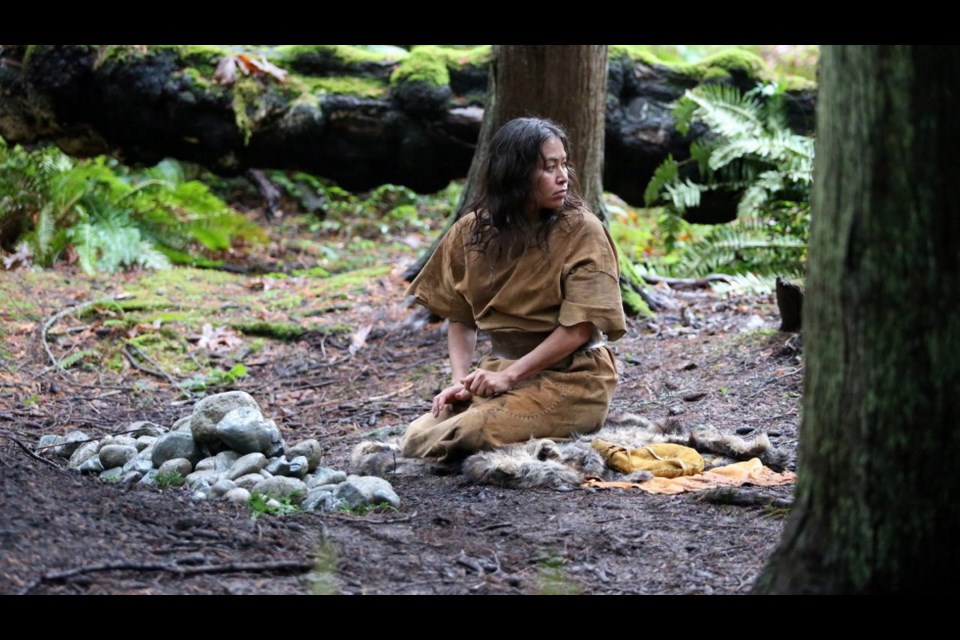If you happened to wander off the trails on the eastern side of the Saanich Peninsula’s largest urban forest on Thursday, you might have found yourself in a time warp.
In a clearing near a Mount Douglas Park roadway, some of the first indigenous people who arrived in the Americas more than 15,000 years ago could be found huddling near a sacred gravesite.
It was for a scene that will open 1491: The Untold Story of the Americas Before Columbus, a docu-drama miniseries co-produced by Victoria’s Aarrow Productions and Animiki See Digital Production.
The eight-part series, based on a book by Charles C. Mann, is slated to air in 2017 on Aboriginal People’s Television Network in sa���ʴ�ý and ZDF in Germany.
“Indigenous people came to the Americas in many different ways,” explained producer Barbara Hager while her 30-person crew wrapped final shots on a rainy afternoon.
“The theory we’re presenting is that first people arrived by boat earlier than by the Beringia land bridge,” said Hager, who is also directing documentary sequences. The land bridge connected Alaska and Asia during the last ice age.
While film and TV production has become commonplace here, the 1491 shoot has a unique vibe, including daily blessings by elders and a predominantly indigenous creative team.
“It’s a smaller crew, more grassroots,” said locations manager Steve Kinghorn. “You see a lot of passion with something like this. There’s definitely a lot of love for this project.”
Still, this daylight-dependent, beat-the-clock shoot was not without challenges, such as having to lug equipment through slippery wilderness trails and “looking out for cars in the background,” said director Lisa Jackson (of the Anishinaabe First Nation).
For continuity reasons, one challenge for actor Isaac Elijah, a buckskin-clad Oneida/Six Nations teenager, was resisting the temptation to brush or wash his shoulder-length hair, which he says he grows because “hair holds memory.”
Jackson also put actors Harold Joe (Cowichan) and Carmen Thompson (Nuu-chah-nulth) through their paces at Mount Doug.
On Friday morning, drone-assisted shooting continued at McKenzie Bight, which Hager said was chosen because “it had the most spiritual feeling, and it looks like a fjord that could be anywhere.”
The art department created a dugout canoe for a sequence depicting the arrival of indigenous people before crews moved on to Goldstream Park for fishing and hunting-camp sequences.
“We’ve been shooting in some of the most beautiful environments you can imagine,” said Jackson, who has already filmed in locations including Taos Pueblo, New Mexico, Machu Picchu in Peru and Mexico’s Yucatan.
“The beautiful thing about the West Coast is that it’s so lush, so every frame is filled with foreground and background, and the way the moss glows in the light is gorgeous.”
One crew member laughingly noted that while “a lot of producers are full of b.s.,” Hager was a producer who instead was willing to actually shovel it, which she did while filming in Merritt.
Hager laughs at the story she says has won her “a few new friends” since she impulsively began cleaning up “cow pies” before filming on farmland.
“I felt they needed to be cleaned up because there were no cows that long ago in North America,” said Hager, no stranger to pitching in by driving crews, serving food or carrying equipment on low-budget shoots.
“Everyone was shocked. What kind of producer does this? But it’s just about getting it done. I grew up on a farm, too, so it was no big deal.”



